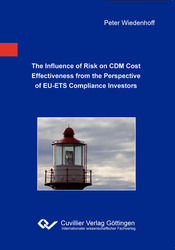| Fachbereiche | |
|---|---|
| Buchreihen (96) |
1378
|
| Nachhaltigkeit |
3
|
| Gesundheitswesen |
1
|
| Geisteswissenschaften |
2365
|
| Medienwissenschaften | 16 |
| Theologie | 57 |
| Philosophie | 102 |
| Rechtswissenschaft | 422 |
| Wirtschaftswissenschaften | 850 |
| Sozialwissenschaften | 416 |
| Sportwissenschaften | 48 |
| Psychologie | 233 |
| Pädagogik | 190 |
| Geschichtswissenschaften | 182 |
| Kunstwissenschaften | 111 |
| Kulturwissenschaften | 166 |
| Literaturwissenschaften | 117 |
| Sprachwissenschaften | 88 |
| Naturwissenschaften |
5406
|
| Ingenieurwissenschaften |
1793
|
| Allgemein |
98
|
|
Leitlinien Unfallchirurgie
5. Auflage bestellen |
|
Erweiterte Suche
The Influence of Risk on CDM Cost Effectiveness from the Perspective of EU-ETS Compliance Investors
Peter Wiedenhoff (Autor)Vorschau
Inhaltsverzeichnis, Datei (42 KB)
Leseprobe, Datei (51 KB)
While the trading prices of issued Certified Emission Reductions (CERs) within the
European Union Emissions Trading Scheme (EU-ETS) are transparent, there is limited
knowledge about the actual origination cost of Clean Development Mechanism (CDM)
projects. Minimum CER prices required for financial viability of a CDM project idea
define a measure for CDM cost effectiveness and indicate the floor price for project
participation. As CDM projects are located in developing countries, they face substantial
implementation and performance risks that need to be considered for CDM cost
effectiveness calculation. As existing studies primarily focus on qualitative risk
assessment, there is a lack of a monetary evaluation of risk impact on CDM origination
cost and CER floor price.
The present study intends to close this gap and introduces a model for calculation of
CDM cost effectiveness taking risks into account from the perspective of EU-ETS
compliance investors. The analysis is based on available CDM project data. To ensure
comparability of results, a standardized project with characteristic technical parameters
is defined for every project type and virtually installed in various developing countries.
For every cluster of project type and host country, investment profitability is calculated.
Associated greenhouse gas (GHG) emission reductions are determined and integrated
into the financial analysis. As a result, the CER floor price specifying CDM cost
effectiveness is derived and indicated in Euros (EUR) per CER.
A simulation based risk model is developed and integrated into the CDM cost
effectiveness calculation. The risk model considers investment profitability and CER
quantity risks and calculates a risk premium to consider the expected financial impact
on the CER floor price. Risk factors are modeled by fitting probability distributions to
underlying base project data. Monte-Carlo simulation (MCS) results in a distribution of
risk-adjusted CER floor prices for every project cluster.
The model is applied to renewable energy technology, energy efficiency, and methane
avoidance projects. Risk influence on CDM cost effectiveness is exemplarily analyzed
for wind onshore projects, landfill gas (LFG) power generation, and waste heat recovery
(WHR) installations. Model output shows that risk has a higher than expected financial
impact which may result in risk premiums of up to three-digit EUR amounts per CER.
The study results provide a scientific added value through integration of financial
evaluation of risk impact into CDM cost effectiveness calculation. The resulting riskadjusted
CER price distributions for CDM cost effectiveness enable the statistical
analyses of CER floor prices. Project clusters with CER price expectations below traded
market prices can be identified. Thus, the outcome not only contributes to CDM market
understanding. It also supports the definition of a CDM investment strategy.
| ISBN-13 (Printausgabe) | 3869556838 |
| ISBN-13 (Printausgabe) | 9783869556833 |
| ISBN-13 (E-Book) | 9783736936836 |
| Buchendformat | A5 |
| Sprache | Englisch |
| Seitenanzahl | 284 |
| Umschlagkaschierung | matt |
| Auflage | 1 Aufl. |
| Band | 0 |
| Erscheinungsort | Göttingen |
| Promotionsort | Braunschweig |
| Erscheinungsdatum | 12.04.2011 |
| Allgemeine Einordnung | Dissertation |
| Fachbereiche |
Wirtschaftswissenschaften
Elektrotechnik |








